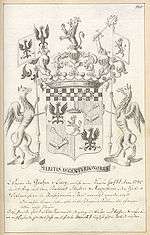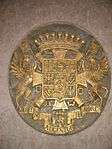Franz Moritz von Lacy
Franz Moritz Graf[1] von Lacy (English: Francis Maurice de Lacy; Russian: Борис Петрович Ласси, tr. Boris Petrovich Lassi; 21 October 1725 – 24 November 1801)[2] was a Baltic German-born Austrian military leader, he was the son of Count Peter von Lacy and was a famous Austrian field marshal. He served during the reign of Maria Theresa and was a close friend to Joseph II, Holy Roman Emperor, becoming one of the latter's advisers. Lacy was made a Count of the Holy Roman Empire.
Franz Moritz von Lacy | |
|---|---|
.jpg) Count von Lacy | |
| Born | 21 October 1725 Saint Petersburg, Russian Empire |
| Died | 24 November 1801 (aged 76) Vienna, Archduchy of Austria, Holy Roman Empire |
| Buried | Neuwaldegg, Vienna |
| Allegiance | |
| Service/ | Habsburg Empire |
| Years of service | 1743–1790s |
| Battles/wars | War of the Austrian Succession
Austro-Turkish War |
| Relations | Peter Graf von Lacy (father) |
Early life

His father, Count Peter von Lacy, was a Russian Field Marshal who belonged to the Irish branch of the de Lacy family and had followed James II into exile. His mother, Countess Margareta Philippina von Lacy, nee von Funcken, was a Baltic German.[3] Franz Moritz was born in St Petersburg, and was educated in Germany for a military career, and entered the Austrian service. He served in Italy, Bohemia, Silesia and the Netherlands during the War of the Austrian Succession, was twice wounded, and by the end of the war was a lieutenant-colonel. At the age of twenty-five he became full colonel and chief of an infantry regiment.
Seven Years' War
In 1756 with the opening of the Seven Years' War he was again on active service, and in the first battle (Lobositz) he distinguished himself so much that he was at once promoted major-general. He received his third wound on this occasion and his fourth at the battle of Prague in 1757. Later in 1757 Lacy bore a conspicuous part in the great victory of Breslau, and at Leuthen, where he received his fifth wound, he covered the retreat of the defeated army. Soon after this began his association with Field-Marshal Daun, the new generalissimo of the empress's forces, and these two commanders, powerfully assisted later by the genius of Laudon, made headway against Frederick the Great for the remainder of the war.
Lacy, a lieutenant field-marshal at thirty-two, was made chief of staff (quartermaster-general) to Daun in the newly created general staff. They were cautious to the point of timidity since Leuthen and many other bitter defeats had taught the Austrians to respect Frederick; but, having resolved to wear out the enemy by Fabian methods, they were strong enough to persist to the end. Thus for some years the life of Lacy, as of Daun and Laudon, is the story of the war against Prussia. After Hochkirch (October 15, 1758) Lacy received the Grand Cross of the Order of Maria Theresa. In 1759 both Daun and Lacy fell into disfavour for failing to win victories, and Lacy owed his promotion to Feldzeugmeister only to the fact that Laudon had just received this rank for the brilliant conduct of his detachment at Kunersdorf. He shadowed Frederick the Great's Prussian army during the failed Siege of Dresden in 1760. His responsibilities told heavily on Lacy in the ensuing campaigns, and his capacity for supreme command was doubted even by Daun, who refused to give him the command when he himself was wounded at Torgau.
Later career
After the Treaty of rg a new sphere of activity was opened, in which Lacy's special gifts had the greatest scope. Maria Theresa having placed her son, Emperor Joseph II, at the head of Austrian military affairs, Lacy was made a field marshal, and given the task of reforming and administering the army (1766). He framed new regulations for each arm, a new code of military law, a good supply system. As the result of his work the Austrian army was more numerous, far better equipped, and cheaper than it had ever been before. Joseph soon became very intimate with his military adviser, but this did not prevent his mother, after she became estranged from the young emperor, from giving Lacy her full confidence. His activities were not confined to the army. He was in sympathy with Joseph's innovations, and was regarded by Maria Theresa as a prime mover in the scheme for the partition of Poland. But his self-imposed work broke down Lacy's health, and in 1773, in spite of the remonstrances of Maria Theresa and of the emperor, he laid down all his offices and went to southern France. On returning he was still unable to resume office, though as an unofficial adviser in political and military matters he was far from idle.
.jpg)

In the brief and uneventful War of the Bavarian Succession, Lacy and Laudon were the chief Austrian commanders against the King of Prussia, and when Joseph II at Maria Theresa's death, became the sovereign of the Austrian dominions as well as emperor, Lacy remained his most trusted friend. More serious than the War of the Bavarian Succession was the Turkish war which presently broke out. Lacy was now old and worn out, and his tenure of command therein was not marked by any greater measure of success than in the case of the other Austrian generals. His active career was at an end, although he continued his effective interest in the affairs of the state and the army throughout the reign of Joseph's successor, Leopold II. His last years were spent in retirement at his castle of Neuwaldegg near Vienna. He is buried in a mausoleum in the castle grounds.
Ancestry
His father was Peter Lacy.
| Ancestors of Franz Moritz von Lacy | |||||||||||||||||||||||||||||||||||||||||||||||||||||||||||||||||||||||||||||||||||||||||||||||||||||||||||||||||||||||||||||||||||||||||||||||||||||||||||||||||||||||||||||||||||||||||||||||||||||||||||||||||||||||||||||||||||||||||||||||||||||||||||||||||||||||||
|---|---|---|---|---|---|---|---|---|---|---|---|---|---|---|---|---|---|---|---|---|---|---|---|---|---|---|---|---|---|---|---|---|---|---|---|---|---|---|---|---|---|---|---|---|---|---|---|---|---|---|---|---|---|---|---|---|---|---|---|---|---|---|---|---|---|---|---|---|---|---|---|---|---|---|---|---|---|---|---|---|---|---|---|---|---|---|---|---|---|---|---|---|---|---|---|---|---|---|---|---|---|---|---|---|---|---|---|---|---|---|---|---|---|---|---|---|---|---|---|---|---|---|---|---|---|---|---|---|---|---|---|---|---|---|---|---|---|---|---|---|---|---|---|---|---|---|---|---|---|---|---|---|---|---|---|---|---|---|---|---|---|---|---|---|---|---|---|---|---|---|---|---|---|---|---|---|---|---|---|---|---|---|---|---|---|---|---|---|---|---|---|---|---|---|---|---|---|---|---|---|---|---|---|---|---|---|---|---|---|---|---|---|---|---|---|---|---|---|---|---|---|---|---|---|---|---|---|---|---|---|---|---|---|---|---|---|---|---|---|---|---|---|---|---|---|---|---|---|---|---|---|---|---|---|---|---|---|---|---|---|---|---|---|---|---|
| |||||||||||||||||||||||||||||||||||||||||||||||||||||||||||||||||||||||||||||||||||||||||||||||||||||||||||||||||||||||||||||||||||||||||||||||||||||||||||||||||||||||||||||||||||||||||||||||||||||||||||||||||||||||||||||||||||||||||||||||||||||||||||||||||||||||||
See also
| Wikimedia Commons has media related to Franz Moritz von Lacy. |
- Irish military diaspora
- Irish regiments
References
- Regarding personal names: Until 1919, Graf was a title, translated as Count, not a first or middle name. The female form is Gräfin. In Germany since 1919, it forms part of family names.
- De Lacy – 1000 Years of History, published by Bernhard Lascy 2013, pg. 359; see also Edward de Lacy-Bellingari: The roll of the house of Lacy: pedigrees, military memoirs and synoptical history of the ancient and illustrious family of De Lacy, from the earliest times, in all its branches, to the present day. Full notices on allied families and a memoir of the Brownes (Camas). Waverly Press, Baltimore (MD) 1928. viii, 409 pages, 24 cm. online
- Clark, George. Irish Soldiers in Europe, 17th-19th Century, pub.2010.

- See memoir by AW Arneth in Allgemeine deutsche Biographie (Leipzig, 1883)
- Ruvigny, Melville H., The Nobilities of Europe